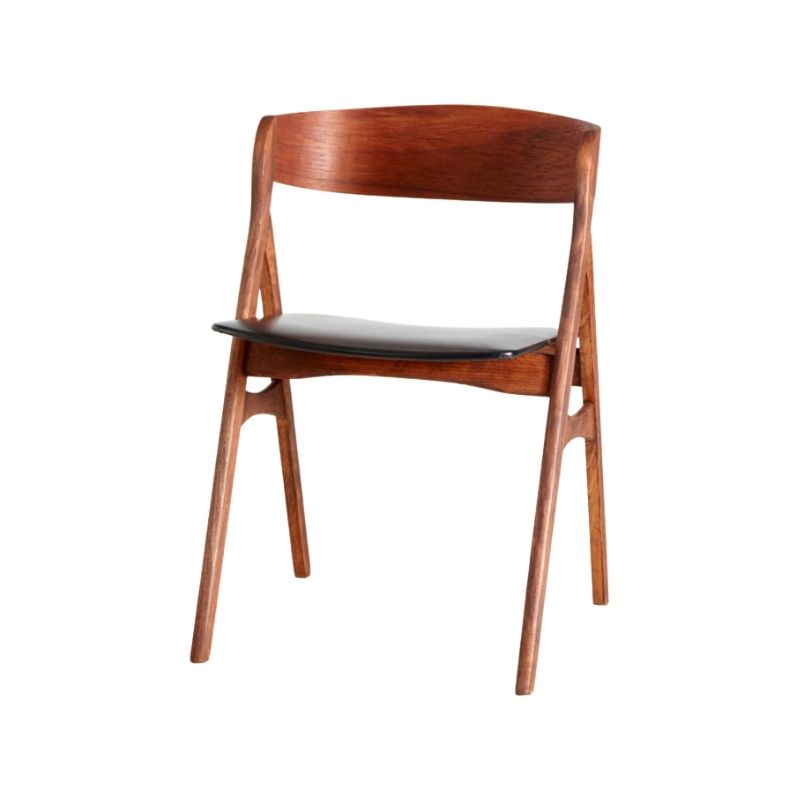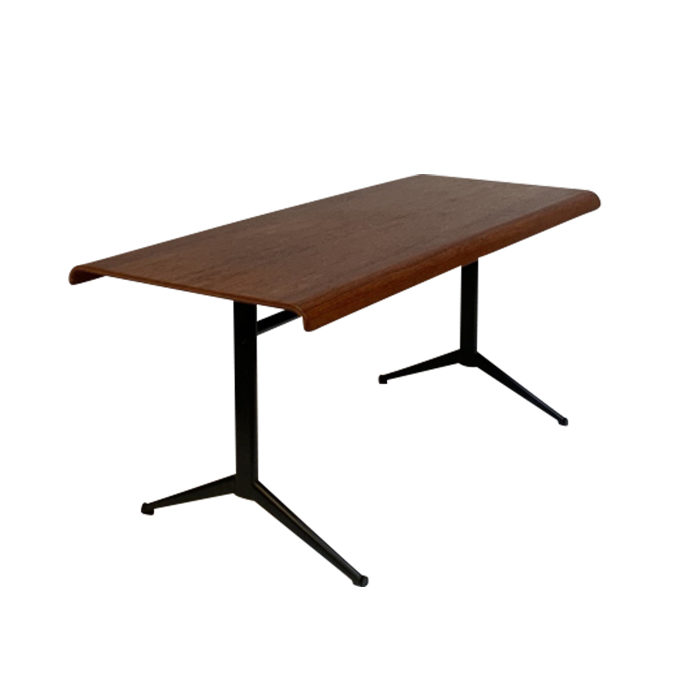Hi,
Here in Belgium I often come by furniture made locally but inspired by scandinavian examples.
These designs in teak and rosewood are (contrary to their danish brothers) most often varnished. Generally I find this quite a shame, as the varnish cracks or discolors and the surface of the wood gets lost.
On the other hand, this finish defines its origin.
What do you do or suggest in such cases of refurbishing?
For instance this table by V-form in teak (wich I would like to sand and oil).
I've also got an anonymous sideboard in oak, wich I really like for its unpretentious character. I'm thinking of soapwashing it, after I've sanded it down and replacing the handles (some are missing).
How far do you sometimes go with altering a piece of furniture? Can you post some pics?
Thanks!
I just had this conversation ...
with my sister-in-law, who refinishes antique furniture. She knows that the "experts" say refinishing is about the worst thing to do to a piece. But she says she doesn't care because her pieces aren't particularly valuable and she's refinishing them for her own use. Also, she often starts with pieces in poor condition.
I stripped and changed the color of my art deco bedroom furniture. It was in only fair condition, the color was blah and the set had little value. I think it's gorgeous, with a simple curved front, and the deep new color enhances the wood. I never had a doubt about changing it.
What I'm debating now is whether to slap some polyurethane on my MCM pieces. None are especially valuable, and it really, really would protect them better than oil and make my life easier.
I think
poly may be the modern miracle. You can try rub-on instead of brush-on -- and there are different levels of gloss to try as well.
There are also acrylics. I have been using an exterior-grade product called
"Breakthrough !" (love the exclamation mark) that is supposed to be bulletproof -- and it may well be. These acrylics are especially colorless -- to the point where it is hard to tell where you've applied it, on the second coat.
I'm experimenting with the ceruse finish for the first time, after long anticipation. This is well-suited to ash and oak; a color coat is applied, and when dry a second contrasting color is wiped onto the wood, where it settles into the recessed pores, and the excess is wiped off. I don't know all the ins and outs of this yet -- so far I have applied paint to raw and sanded red oak, and then sanded the coat off with an orbital sander, leaving color in the open grain. Then I applied a coat of clear acrylic. Pretty sexy, if you care for that sort of thing.
Has anyone tried this ? The ceruse pieces we may all have seen have a Hollywood/hothouse look; pieces made in the 'forties and 'fifties (and maybe earlier) were often black with white graining. A Parisian named Frank apparently made his name with this finish, in the late 'twenties or early 'thirties, as I recall it.
I have a brainstorm for the poster, to replace the existing pulls on that handsome credenza: a single bar of wood, either matching the wood (to look like an original feature) or contrasting. This would be attached through the existing holes, so (no matter how valuable) the furniture piece would remain unaltered and undamaged. . .
Cool, huh ? Who says there's nothing new under the sun. . .!
Do you have any images? Findi...
Do you have any images? Finding it hard to imagine.
I've put high gloss clear acrylic over paint (on wood and steel) before, it looks excellent, almost like a piano finish, but I wouldn't want to repair it and on the white painted steel it has stained badly, spilt coffee mostly, maybe I did something wrong.
Hmm. . .
I guess I can't recommend the most stain-resistant finish. I'm told they make a clear powder-coat -- and that wood can be powder-coated. Anybody know if that is correct ? (For all I know, powder-coat finishes are no more stain resistant than others -- it just seems that would be a bullet-proof material (there I go again).
Here's my first efforts with the finish I described above. The first image is my sample board, with four clear finishes over the grain-tinted red oak. I used a custom-mixed latex interior paint in a warm green. The clear finishes (from the top) are:
Formby's Tung Oil Finish -- low gloss
Briwax Original -- clear
Minwax Wipe-on Poly -- clear satin
Breakthrough ! -- clear gloss
(uncoated)
I like the rosy warmth of the oak in contrast to the green grain. The wax for some reason picked up the green tint of the paint (not a perfect test, as I neglected to clear the panel of sanding dust, so there was some fine greenish dust on the surface for the first two finish materials).
The second image is my first three boards -- same material as the sample -- coated with the Breakthrough product.
I suppose the finish depends...
I suppose the finish depends on the conext, wax, soap etc seems fine for domestic furniture, the acrylics and polys for commercial use where its not maintained and subject to more wear...these days I try and avoid anything I wouldn't want to stick in my mouth or breathe in too deeply, how long did the tung oil take to dry?
Using vaseline on turnings is my new favourite, its not at all greasy after buffing and is very fast though I want to try walnut oil too. The periodic maintenance of 'natural' finishes is almost fun, if you like that sort of thing.
Yeah --
well, I'm apparently impervious to chemicals and dusts, and for me the one-time application of a permanent finish, in a nice low-gloss sheen, perhaps, beats forgetting to recoat, and having some dummy put a wet glass on my nice wood. But I get your point. All of these polys and acrylics I'm trying are water-based, yet seem to perform like oil-based finishes of old -- with no fumes or odor. A modren miracle, I tells ya. . .!
Vaseline huh ? How about yak butter -- or KY ?
The tung oil dried pretty fast. I'll look at the directions again when I get to the shop. It did seem to impart the most color to this oak. . .
Tung oil
It dries within about 36 hours. The can says 24, I think, but it still seemed tacky in a few spots.
For my MCM pieces, I have cleaned them thoroughly and there's always some spot where the finish is peeling. Then I coat them with matching stain and apply tung oil when they are dry. Tung oil is a beautiful finish, but it's impractical for the abuse it's getting in my house.
Now, it's time to recoat, and I'm finding that I don't want to rip apart my living room to re-oil. So if I take them to the garage again, I will coat them with poly.
I'd
worry that no other finish would stick, once oil or wax have been applied. What do you know about that ? Glad to know people are having success with tung oil, though. . .
Finish has always been someone else's problem, in my career. Now I'm "it." So it's time to get up to speed. In the past I've finished a few pieces with Deft brushable lacquer -- easy apply, nice waxy feel, but not a durable finish for a tabletop,say.
I'm certainly not doing production, or volume -- just little one-off projects, with clear finishes. But I want to play with colors, now. . .while retaining the "woodness" of the materials.
If you need any help, please contact us at – info@designaddict.com









